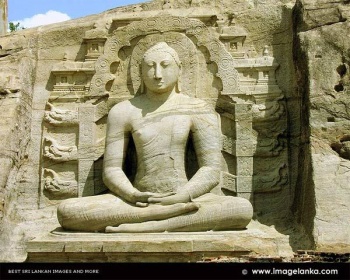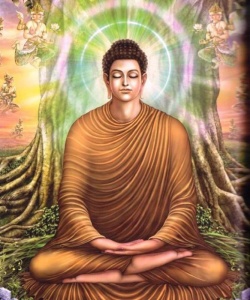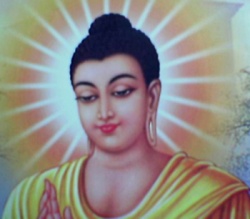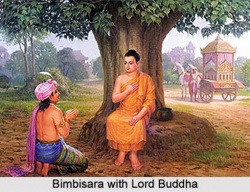The Buddha and Buddhism
"The human race has often expected someone to arise who could solve the difficulties of human beings. History shows this, the Jews expected the "Messiah", is a special being sent by God.
Hindus expected avatars or messengers of God. The human race has always wanted someone to guide or lead them. In Northern India, after Vedic and Upanishad times, there appears to have been the expectation of a great leader, a be Buddha, an awakened One.
So when Siddhartha Gautama came from the forest and said "I have discovered the deathlessness", he was a fulfillment of this expectation. He was the Buddha, the Awakened One. Here was what mankind expected. Such a person never arises except once in a blue moon. Very rare, very, very."
This quotation from The life of the Buddha by Bhikkhu Nanamoli, proves the urgency of such a great person. The rich merchant of Rajagaha said to the merchant Anathapindika, " I have invited for tomorrow the Community of Bhikkhus headed by the Buddha, the Enlightened One. Then this conversation took place between them.
Anathapindika : Do you say "the Buddha"?
Merchhant of Rajagaha: I say "the Buddha".
Anathapindika : Do you say "the Buddha"?
Merchant of Rajagaha : I say "the Buddha"
Anathapindika : Do you say "the Buddha"?
Merchant of Rajagaha : I say "the Buddha".
Anathapindika : This news "the Buddha, the Buddha" is hard to come by in the World. Is it possible to go and see this Blessed One, accomplished and fully enlightened, now at this time?"
For our good fortune, a full Enlightened being has arisen in our historical times. He was neither a Creator nor a messenger. As a human being he was born in 623 BC in India. He was known as Siddhartha Gautama. The place where he was born is called Lumbini or, today, Rummindei. It is about one hundred miles to the north from Varanasi, in Uttar Pradesh, India.
This is one of the four most sacred places the sight of which should arouse emotion, sense of urgency (Samvejaniyani Thanani). Today most pilgrims visit there and pay their homage to the Buddha. There is a mighty stone pillar to mark this holy spot. It was erected by the Emperor Asoka about 300 years after the demise of the Buddha.
The birth of the Master took place on the full Moon day of Vesak. According to the Buddhist scriptures, he came out of the womb mindfully, lived in society mindfully, and passed into Parinibbana mindfully. He was born to a Royal family. His father was Suddhodana and mother was Mahamaya. According to the life story of the Buddha, his mother, Mayad away seven days after the delivery of the baby.
So the little prince was looked after by his foster mother, Prajapathi, the pioneer of the Bhikkhuni Order. As the prince was being brought up in a model manner with the provision of every need, his story spread over all the citizens of the country.
According to the custom of the day at the age of sixteen he was married to princess Yasodara. The couple led a luxurious life knowing nought of sorrow. But the prince began to see the rents in his worldly life. There was no satisfaction he could discover in all these happiness.
Day by day he was disgusted and disappointed and ultimately he decided to relinquish the worldly life. His great renunciation took place on the Full Moon day of July (Esela). On the day of his renunciation he received a message that his wife had delivered a baby. But even that spurred him to go from home to homelessness.
After reaching a far place he became an ascetic . Then he wandered from place to place seeking what is truth. Meeting some eminent teachers like Alara Kalama and Uddaka Ramaputta he learnt their teachings but did not gain what he sought. Though he practised severe austerities for six years he could not achieve his goal.
Therefore, Finally he himself strove to realise the Dhamma and when he was 35, he attained Full Enlightenment on the Full Moon Day of Vesak.
When we consider the unparalleled characteristics of the Buddha we can come to a conclusion that it was because of his ever alert mindfulness that he attained full enlightenment, realising the Dhamma not known before. Realising the truth the Buddha said "Vision of insight arose in me, unshakable is the deliverance of my heart. This is my last birth. Now there is no more re-becoming."
The Dhamma realised through his intuitive wisdom and revealed by the Tathagata, the Buddha, is Buddhism. The Buddha realised the Four Noble truths.
In the World there is one truth: suffering. So these are not four truths but four levels of the truth. "Monks it is through not understanding, not penetrating the Four Noble Truths that I, as well as you, have, for a long time, run on and gone round the cycle of birth and death." The Buddha said.
These Four Noble Truths are:
1. The Truth of Suffering (Dukkha Sacca)
2.The Truth of the arising of suffering (Samudaya Sacca)
3.The Truth of the cessation of Suffering (Nirodha Sacca)
4.The Truth of the Path leading to the cessation of suffering (Magga Sacca)
The path leading to the cessation of suffering is the Middle path (Avoiding of the two extremes). There are two extremes in the world: sensual indulgence (Kamasukhallikanu Yoga) and self mortification (Attakilamathanuyoga).
The Path he practised was the Middle Path (Majjhima Patipada). According to the Nagara Sutta of the Samyutta Nikaya it was an Ancient Path (Purana Maggam). This Middle path is nothing but the Noble Eight-fold Path.
1. Right Understanding (Samma Ditthi)
2. Right Thought (Samma Samkappa)
3. Right Speech (Samma Vaca)
4. Right Action (Samma Kammantha)
5. Right Livelihood (Samma Ajiva)
6. Right Effort (Samma Vayama)
7. Right Mindfulness (Samma Sati)
8. Right Concentration (Samma Samadhi)
After His Enlightenment, Buddha did not remain silent. He commenced service to all mankind, regardless of the minor differences between people. The Buddha, in his 80 years of life, from 35 to 80, rendered an unparalleled service to all beings in the world.
After completion of his 45 years of mission, at the age of 80, the Buddha passed into Parinibbana. Before his Parinibbana the Buddha addressing his attendant Ven. Ananda, weeping at the approaching demise of the Buddha, said "Ananda, there is no attachment between us. There is nothing to share between us. So there is no pain of separation. Ananda, you cannot understand this.
Although you have no attachment to anything, you are still attached to your Teacher. It is the love and attachment you have for me that has become an obstacle to your realising the Truth. Ananda, your Teacher can show you only the Path.
He cannot make you enter Nibbana. It's by you that all defilements have to be destroyed. As one has to seek one's own salvation, Ananda, after my death, strive with diligence and gain the Fruits of Deliverance." This kind admonition of the Buddha is not only meant for Venerable Ananda, but it is relevant to all of us.
Let us take this advice of the Buddha deep into our hearts during this period of Vesak.



